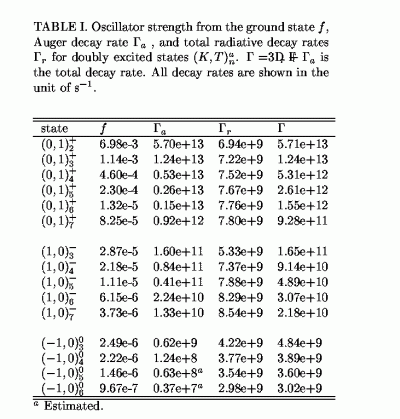1) Department of Physics, Kansas State University, Manhattan, Kansas, USA
2) Department of Physics, National Chung-Hsin University, Taichung, TAIWAN
Helium is the prototype system for the study of electron correlation. Manifestations of doubly excited states as resonances in the photoionization spectra have been studied extensively in the last few decades. Most of the previous theoretical and experimental studies of helium doubly excited states assume that Auger process dominates the decay mechanism. However, continuing progress in synchrotron light sources in the last few years has now offered experimentalists the opportunity to examine the radiative decays of the helium doubly excited states1-4.
We present a theoretical study for the radiative decay of the low-lying doubly excited 1Po states of helium below the He+(N=2) threshold. From the calculated Auger and radiative decay rates, the natural widths of these states are obtained. By following the radiative decay branches of individual doubly excited states, including all the cascade transitions, we derive the expected VUV photon yields and the metastable atom yields in the fluorescence spectra. These data serve to compare with the recent experimental measurements2,3.
The radiative decay rate of individual doubly excited states reflects the importance of configuration mixing. Neglected by most prior studies, radiative decay is shown to be more important than autoionization in the decay mechanism of some doubly excited states. Among the low lying states, the (-1,0)0n series decays predominantly via radiative channels, while Auger process dominates the decay of (0,1)+n and (1,0)-n series. With increasing brightness available from synchrotron radiation sources, it is becoming possible to examine the radiative branch of the decay of doubly excited states of helium. These data for radiative decay rates would provide critical information on those doubly excited states which have so far been neglected both theoretically and experimentally.

References:
1) E. Sokell, A.A. Wills, P. Hammond, M.A. MacDonald, and M. K. Odling-Smee, J. Phys. B 29, L 863 (1996).
2) M. K. Odling-Smee, E. Skoell, P. Hammond, and M. A. MacDonald, Phys. Rev. Lett. 84, 2598 (2000).
3) J.-E. Rubensson, C. Såthe, S. Cramm, B. Kessler, S. Stranges, R. Richter, M. Alagia, and M. Coreno, Phys. Rev. Lett. 83, 947 (1999).
4) T. W. Gorczyca, J.-E. Rubensson, C. Såthe, M. Ström, M. Agaker, D. Ding, S. Stranges, R. Richter, and M. Alagia, Phys. Rev. Lett. 85, 1202 (2000).
This work was supported by the
Chemical Sciences, Geosciences and Biosciences Division,
Office of Basic Energy Sciences,
Office of Science,
U.S. Department of Energy.
MKC was supported by National Science Council Grant No. NSC-870-0212-M-005-006.
Submitted to ICPEAC 2001, July 2001 in Santa Fe, NM.
This abstract is also available in Postscript or Adobe Acrobat formats.
|
|